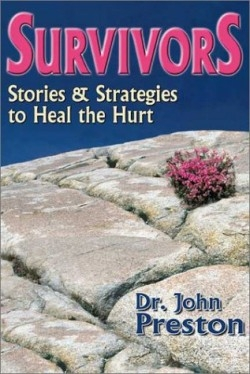Survivors
Stories and Strategies to Heal the Hurt
Talk is cheap—unless
you’re paying a therapist who says things like “I know how you feel.” The author, a psychologist, knows better than to make such a facile claim. He knows that “at the heart of a truly helpful, healing relationship (whether in the context of a friendship or in psychotherapy) is the capacity for one person to genuinely listen and gradually come to understand the unique experience of the other.” Books cannot listen, but they can remind the reader how it feels to be heard, and helped.
Preston uses four cases to anchor his comprehensive approach—stories that illustrate types of stress, characteristic responses to it, and the various ways people heal. While focusing on the psychological and interpersonal, the author also covers the physical—chemistry, brain trauma, diet, exercise, medication—and the social. He writes about the importance of core beliefs in cognitive therapy, and introduces the “good enough mother” of D. W. Winnicott and the stress response syndrome described by Mardi Horowitz. There is a balance of theory and therapy, so the reader will feel informed as well as encouraged.
Preston has a sure touch with metaphor. Discussing the “toxic relationship,” he explains why leaving it can be so hard: “Even a bush struggling in lousy soil can be damaged as it is being lovingly transplanted to a healthier spot. Its roots have found a home in the inadequate soil.” He continues: “Hopes and ideals… serve as flotation devices, helping us keep emotionally afloat even in a sea of toxic interactions.” Suggestions have user-friendly tones; a relaxation exercise is spelled out in detail along with an attractive visualization technique that will encourage readers to try it.
Some self-help approaches, Preston rightly warns, are prone to major mistakes: one is the cookbook, simplified recipe approach to all problems; another the tendency to pathologize everything—to overuse the dysfunction/illness label and attach it to a single cause. This book faces the real complexity in both the cause of hurt and the recovery from it. While it demands more of the reader than some books, it gives back more in proportion. At the end is a summary of serious disorders and sensible guidance on getting therapy. This book stands out in a crowded field.
Disclosure: This article is not an endorsement, but a review. The publisher of this book provided free copies of the book to have their book reviewed by a professional reviewer. No fee was paid by the publisher for this review. Foreword Reviews only recommends books that we love. Foreword Magazine, Inc. is disclosing this in accordance with the Federal Trade Commission’s 16 CFR, Part 255.

